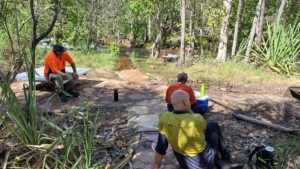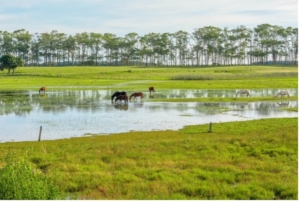This update represents just a handful among the hundreds of NRM projects happening across Australia, which are made possible through funding from the Australian Government and respective State/Territory governments.

Southern Gulf NRM in Queensland are working with land managers to restore riparian areas after the monsoon event in early 2019, which caused swelling of riverbanks and waterways well beyond their capacity. In some areas, 100m of the riverbank was lost, resulting in 8-metre-high cliff faces.
Five sites, two on the Flinders River and one each as Alick Creek, Cloncurry River and Dutton River were identified at priority locations. Neilly Group Engineering and Southern Gulf NRM recommended back battering of eroded sections, installation of irrigation at suitable sites and revegetation on the reprofiled bank batters.
Ongoing evaluations of monitoring sites have been established to prevent future erosion.

The southern brown bandicoot is a nationally listed endangered species. Hills and Fleurieu Landscape Board in South Australia is undertaking region-wide surveys to help determine where they still occur.
The Bandicoot Superhighway project team is asking local communities to assist them in their search for the bandicoot. Southern brown bandicoots are the only species of bandicoot left in the Mount Lofty Ranges and Fleurieu Peninsula region.
Visit the Bandicoot Superhighway project webpage for more information and a link to the portal to add sightings.
Find out more about the bandicoot here.
Image by Kirstin Abley

A key part of providing water to greater Melbourne is the water treatment and transfer plants. In order to reduce the emissions produced by these essential services, Melbourne Water recently completed a solar farm at its Winneke Water Treatment Plant.
In an Australian First, Melbourne Water has utilised terrain tracking sensors for the solar farm’s construction. By avoiding extensive earthworks, the panels were installed with minimal ground disturbance, with the total estimated carbon reductions being 12,000 TCO2-e/annum (Tonnes Carbon Dioxide Emissions per annum).

The Gamba Army coordinated by Territory NRM in NT recently travelled to Litchfield National Park to lend a hand to the local indigenous Litchfield Rangers.
With the aerial gamba management program up and running, the Gamba Army went to provide some on the ground support for treatment to cover sensitive areas where aerial management can be difficult to undertake. Aerial kills of mature gamba plants can allow for Kakadu native grass species to flower.
Perth NRM has published the summary information from the Interim Report on the WA Food Security Project (2019-23).
The information is presented as a webinar using chapters so those interested can view the segments relevant to them and provide additional feedback before the report is finalised in April.
The plan is to work with supply chain sectors/regions that would like to consolidate their findings in sub reports, to represent their sectors seeking change. Perth NRM is seeking feedback by late March/mid-April. To view the webinar click here or on the image to the left.

Local Land Services in NSW is delivering the Early Needs Recovery Program in collaboration with the Department of Regional NSW and the NSW Department of Primary Industries.
Through this program, volunteer-based not-for-profit organisations have received vital support to help re-build, repair and clear fences in flood-affected areas along the east coast of NSW. Three not-for-profit organisations secured a share in $1 million in funding, as part of the Fence Rebuilding Program that will run until April 2024 and is expected to see approximately 660km of fences re-built, repaired or cleared, assisting up to 560 primary producers.

Tasmania is home to a unique and critically endangered ecological community known formally as ‘Tasmanian forests and woodlands dominated by Black gum or Brookers gum’. These forests have declined by 90% from across northern and eastern Tasmania – mostly due to historical agriculture and forestry activities.
NRM South aims to protect what is left of these forests as a part of their broader Threatened Plants Project. To achieve this they have been working with landholders across southern Tasmania using conservation covenants and a forest on farms program.

With the upcoming spray season, Wheatbelt NRM held a ‘refresher’ course to ensure the safety of their Rangers and give them the confidence and skills they need when applying and handling chemicals.
The Wheatbelt NRM’s Noongar Boodjar Rangers are continuing their professional development this week by attending a 2 day Apply Chemicals Under Supervision Course run by Central Regional TAFE, following culturally appropriate training methods.

The South West Catchment Council (SWCC)’s ‘Pasture Challenge’ has been taken up by local producers, by designing trials to overcome productivity constraints on a paddock near Busselton, WA.
A range of soil tests were conducted at the site late last year, with results outlines to producers in February by a local agronomist, Graham Mussell. Four groups were formed to develop separate agronomic packages which will now form part of the trial.
SSWC is now inviting producers and non-producers to join one of these groups, which will put them in the running to win free agronomic support and tissue test analysis.

